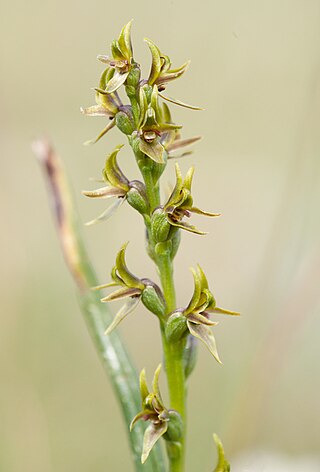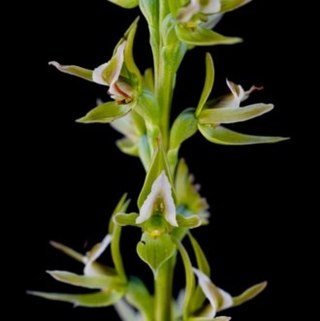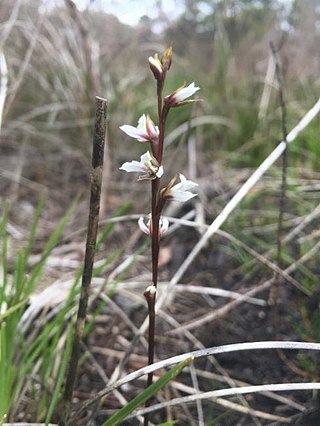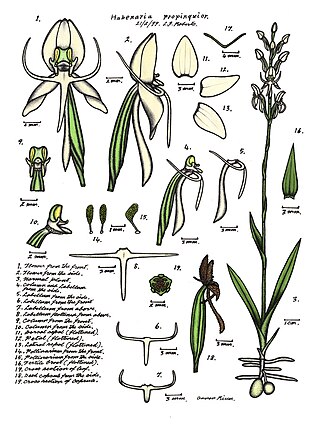
Prasophyllum tadgellianum, commonly known as the alpine leek orchid, is a species of orchid native to the Snowy Mountains and Tasmania. It has a single stiff, erect leaf and up to twenty scented, greenish-brown or reddish-brown flowers crowded on a stout spike.
Caladenia lindleyana, commonly known as the Lindley's spider orchid is a species of orchid endemic to Tasmania. It has a single, hairy leaf and one or two greenish-yellow flowers tinged with red and with thin dark tips on the sepals. Very few plants of this species survive with only one plant, which has not been seen since 1997, protected in a reserve.

Caladenia multiclavia, commonly known as the lazy spider orchid is a species of orchid, endemic to the south-west of Western Australia. It has a single, hairy leaf and one or two greenish-yellow, red and cream-coloured flowers resembling a reclining spider. Although it usually only has a single flower, it often grows in clumps of up to six plants.
Prasophyllum australe, commonly known as the southern leek orchid or austral leek orchid, is a species of orchid and is endemic to south-eastern Australia. It has a single tubular, green leaf and up to fifty scented, greenish-brown flowers with red stripes.
Prasophyllum anticum, commonly known as the Pretty Hill leek orchid, is a species of orchid endemic to Victoria. It has a single tubular, dark green leaf and between ten and twenty five scented, greenish-brown flowers and is only known from a small area in the south-west of the state.

Prasophyllum fimbria, commonly known as the fringed leek orchid, is a species of orchid endemic to the south-west of Western Australia. It is a tall orchid with a single smooth, tube-shaped leaf and up to seventy greenish-brown flowers with a white and pink labellum.

Prasophyllum montanum, commonly known as the mountain leek orchid, is a species of orchid endemic to eastern Australia. It has a single tubular, green leaf and up to fifty scented, greenish to pinkish flowers. It grows in montane ecosystems at altitudes above 1,500 m (5,000 ft).

Prasophyllum brownii, commonly known as the Christmas leek orchid, is a species of orchid endemic to the south-west of Western Australia. It is one of the last of the genus in Western Australia to flower and has a tall flowering stem with up to eighty pale green and fawn-coloured flowers.
Prasophyllum cucullatum, commonly known as the hooded leek orchid, is a species of orchid endemic to the south-west of Western Australia. It is a tall orchid with a single smooth, tubular leaf and up to fifty or more purplish-red and white flowers with a frilled labellum crowded along a relatively short flowering stem.
Prasophyllum drummondii, commonly known as the swamp leek orchid, is a species of orchid endemic to the south-west of Western Australia. It is a late-flowering species with a single tubular leaf and up to thirty brownish-orange or pale yellow flowers and often grows in standing water.
Prasophyllum fecundum, commonly known as the self-pollinating leek orchid, is a species of orchid endemic to South Australia. It has a single, smooth, tube-shaped leaf with a reddish or purplish base, and up to twelve relatively small green and purplish flowers. The flowers are short-lived and self-pollinating although attractive to insects.
Prasophyllum gilgai, commonly known as the gilgai leek orchid, is a species of orchid endemic to Victoria. It has a single tubular green leaf and up to twenty greenish brown, light brown, pink or white flowers. It is a very rare orchid with a population of fewer than fifty plants in a small area in the north of the state.

Prasophyllum hians, commonly known as the yawning leek orchid, is a species of orchid endemic to the south-west of Western Australia. It is a common, tall leek orchid with a single smooth, tubular leaf and up to fifty or more pink and fawn flowers with a frilly labellum.
Prasophyllum laxum, commonly known as the lax leek orchid, is a species of orchid endemic to a small region of South Australia. It has a single tubular leaf and up to twenty pale green, tan and lilac-coloured flowers. It was first collected in the 1960s in a location known as the Hundred of Koppio on the Eyre Peninsula but was not described until 2008 from a new collection in 2004.
Prasophyllum litorale, commonly known as the coastal leek orchid, is a species of orchid endemic to southern continental Australia. It has a single tubular leaf and up to forty flowers with red and green colouring and grows in sandhills near the sea.
Prasophyllum niphopedium, commonly known as the marsh leek orchid, is a species of orchid endemic to a small area in Victoria. It has a single tubular leaf and up to twenty greenish flowers with reddish markings. It is only known from five population on grassy alpine plains with the total number of individual plants less than five hundred.
Prasophyllum parviflorum, commonly known as the slender leek orchid, is a species of orchid endemic to eastern Victoria. It has a single tubular leaf and up to thirty greenish-brown to purplish flowers. Further studies of the species may indicate that some collections currently included may be of a different species.

Prasophyllum striatum, commonly known as the streaked leek orchid, is a species of orchid endemic to New South Wales. It has a single thin, tube-shaped leaf and up to ten greenish and whitish flowers with reddish or purplish stripes. It differs from other leek orchids in having a very thin leaf and prominently streaked flowers.
Microtis brownii, commonly known as the sweet mignonette orchid or sweet onion orchid, is a species of orchid endemic to the south-west of Western Australia. It has a single hollow, onion-like leaf and up to sixty small, green and white scented flowers well-spaced along the flowering stem. It usually grows in swampy places, flowers more prolifically after summer fires and sometimes forms very large colonies.

Habenaria propinquior, commonly known as the common rein orchid, is a species of orchid that is endemic to north Queensland. It has two to four leaves at its base and up to thirty white flowers with thread-like lobes on the labellum.








